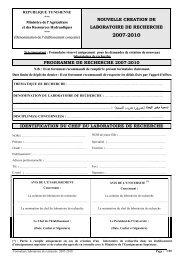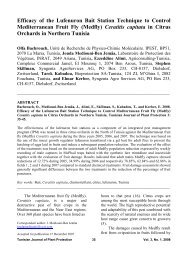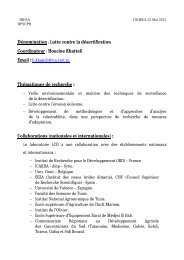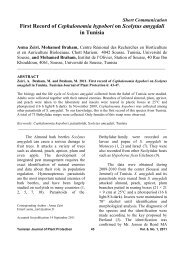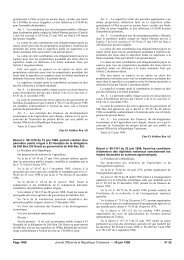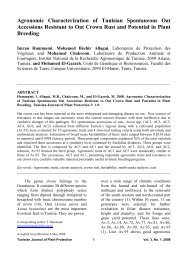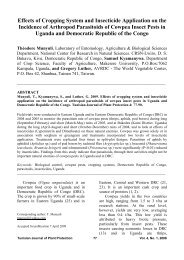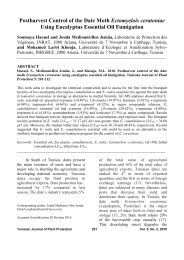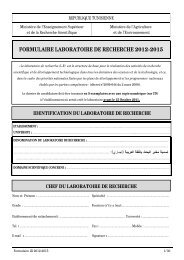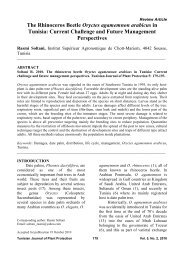Cyromazine Induced Effects on Larvae and Adults of ... - Iresa
Cyromazine Induced Effects on Larvae and Adults of ... - Iresa
Cyromazine Induced Effects on Larvae and Adults of ... - Iresa
Create successful ePaper yourself
Turn your PDF publications into a flip-book with our unique Google optimized e-Paper software.
<strong>of</strong> the pre-adult life stages <strong>of</strong> insects, <strong>and</strong><br />
are effective against many insects (25).<br />
<str<strong>on</strong>g>Cyromazine</str<strong>on</strong>g>, N-cyclopropyl-1,3,5-<br />
triazine-2,4,6-triamine, is an atypically<br />
substituted s-triazine, which acts as an<br />
insect growth regulator used as a chitin<br />
synthesis inhibitor for fly c<strong>on</strong>trol in cattle<br />
manure, field crops, vegetables <strong>and</strong> fruits<br />
(7, 34). It is an effective larvicide against<br />
a number <strong>of</strong> dipteran <strong>and</strong> lepidopteran<br />
species (20, 29). <str<strong>on</strong>g>Cyromazine</str<strong>on</strong>g> has a good<br />
activity against many dipteran species,<br />
especially when it is orally administered<br />
to larvae which usually exhibit a wide<br />
range <strong>of</strong> different morphological<br />
abnormalities (3, 15, 27, 35).<br />
<str<strong>on</strong>g>Cyromazine</str<strong>on</strong>g> is characterized by a<br />
rapid stiffening <strong>of</strong> the cuticle, affecting<br />
mostly larvae <strong>of</strong> Diptera (9, 14, 18).<br />
Reynolds <strong>and</strong> Blakey (29) have shown<br />
that an early acti<strong>on</strong> <strong>of</strong> cyromazine leads<br />
the cuticle to become less extensible<br />
when subjected to simple c<strong>on</strong>stant load<br />
extensi<strong>on</strong> tests. They have suggested that<br />
the cyromazine-induced reducti<strong>on</strong> in<br />
cuticle extensibility may be resp<strong>on</strong>sible<br />
for the other symptoms <strong>of</strong> pois<strong>on</strong>ing <strong>and</strong><br />
hence may be the primary effect <strong>of</strong> the<br />
insecticide. Moreover, cyromazine<br />
induces gross deformities manifest in<br />
larvae <strong>and</strong> pupae <strong>of</strong> dipteran insects (3,<br />
9), <strong>and</strong> also reduces egg laying <strong>and</strong> egg<br />
hatch when fed to Lucilia cuprina adult<br />
(38). Moreover, Alam et al. (2) clearly<br />
dem<strong>on</strong>strated that cyromazine, ingested<br />
by female flies, is incorporated into eggs<br />
<strong>and</strong> inhibits larval development in the<br />
first generati<strong>on</strong>.<br />
<str<strong>on</strong>g>Cyromazine</str<strong>on</strong>g> is also effective as<br />
foliar spray in horticultural crops against<br />
leafminers (Liriomyza spp.) <strong>and</strong> various<br />
other insects, including fleas, thrips, <strong>and</strong><br />
coleoptera (18, 32). It is reported to be a<br />
main translaminar pesticide used to<br />
c<strong>on</strong>trol respectively the pea leafminer<br />
Liriomyza huidobrensis <strong>and</strong> the<br />
serpentine leaf miners (L. trifolii) (13, 17,<br />
30, 37). <str<strong>on</strong>g>Cyromazine</str<strong>on</strong>g> was used because it<br />
is harmless to parasitoids (6, 31).<br />
Recently, there is an increasing trend<br />
am<strong>on</strong>g <strong>on</strong>i<strong>on</strong> growers in New York to<br />
manage <strong>on</strong>i<strong>on</strong> maggot using a<br />
combinati<strong>on</strong> <strong>of</strong> cyromazine seed<br />
treatment <strong>and</strong> chlorpyrifos (Lorsban 4E,<br />
Dow AgroSciences LLC) in furrow<br />
treatments (28). The Medfly, C. capitata<br />
was reported am<strong>on</strong>g the susceptible<br />
species to cyromazine applicati<strong>on</strong>s (35).<br />
<strong>Larvae</strong> when reared <strong>on</strong> an artificial diet<br />
supplemented with different<br />
c<strong>on</strong>centrati<strong>on</strong>s <strong>of</strong> cyromazine, suffer from<br />
severe developmental disrupti<strong>on</strong><br />
depending <strong>on</strong> larval age <strong>and</strong> durati<strong>on</strong> <strong>of</strong><br />
exposure (11, 36). Symptoms <strong>of</strong><br />
pois<strong>on</strong>ing include body malformati<strong>on</strong>s,<br />
such as swelling <strong>of</strong> the integument <strong>and</strong><br />
el<strong>on</strong>gati<strong>on</strong> <strong>of</strong> the larvae, as well as<br />
inhibiti<strong>on</strong> <strong>of</strong> larval growth, increase <strong>of</strong><br />
larval mortality <strong>and</strong> a lower pupati<strong>on</strong> <strong>and</strong><br />
adult emergence rate. Furthermore, Budia<br />
<strong>and</strong> Viňuela (10) reported that the<br />
delivery <strong>of</strong> cyromazine could affect the<br />
reproducti<strong>on</strong> <strong>and</strong> larval development <strong>of</strong><br />
C. capitata.<br />
The present work aims to assess<br />
cyromazine effects <strong>on</strong> larvae <strong>and</strong> adults<br />
<strong>of</strong> Tunisian Medfly strain reared under<br />
laboratory c<strong>on</strong>trolled c<strong>on</strong>diti<strong>on</strong>s.<br />
MATERIALS AND METHODS<br />
Insect. <strong>Larvae</strong> <strong>of</strong> C. capitata were<br />
reared <strong>on</strong> an artificial diet based <strong>on</strong> wheat<br />
bran, sucrose <strong>and</strong> yeast (Table 1). The<br />
wheat bran was first sterilized at 120°C<br />
for two hours. After that, all solid<br />
ingredients were weighed <strong>and</strong> mixed until<br />
a homogenous c<strong>on</strong>sistency was reached.<br />
Liquid yeast <strong>and</strong> hydrochloric acid were<br />
then added. To avoid bacterial <strong>and</strong> fungal<br />
c<strong>on</strong>taminati<strong>on</strong>s, sodium benzoate <strong>and</strong><br />
nipagin were added to the diet.<br />
The rearing culture was kept in a rearing<br />
room at 27 o C ± 1 o C, 75 ± 5% R.H <strong>and</strong><br />
under c<strong>on</strong>tinuous light.<br />
Tunisian Journal <strong>of</strong> Plant Protecti<strong>on</strong> 214 Vol. 5, No. 2, 2010




